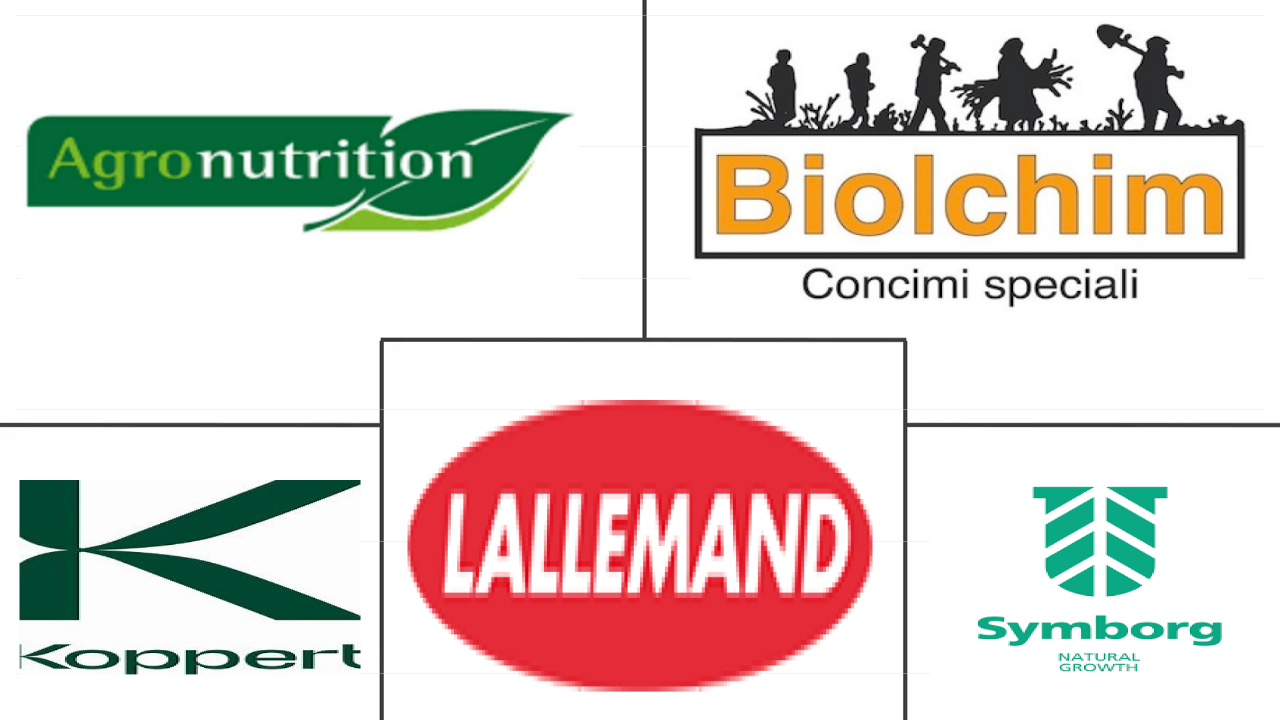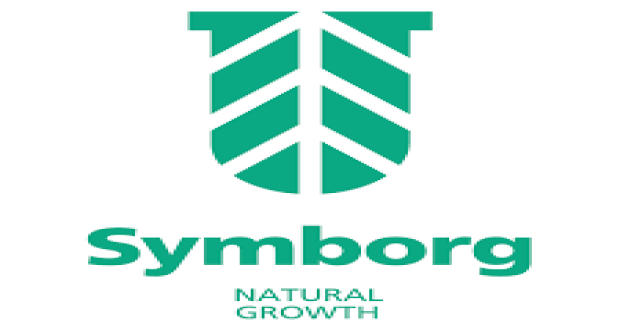Market Size of europe biofertilizer Industry
|
|
Study Period | 2017 - 2029 |
|
|
Market Size (2024) | USD 1.04 Billion |
|
|
Market Size (2029) | USD 1.63 Billion |
|
|
Largest Share by Form | Mycorrhiza |
|
|
CAGR (2024 - 2029) | 9.40 % |
|
|
Largest Share by Country | France |
Major Players |
||

|
||
|
*Disclaimer: Major Players sorted in no particular order |
Europe Biofertilizer Market Analysis
The Europe Biofertilizer Market size is estimated at 1.04 billion USD in 2024, and is expected to reach 1.63 billion USD by 2029, growing at a CAGR of 9.40% during the forecast period (2024-2029).
1.04 Billion
Market Size in 2024 (USD)
1.63 Billion
Market Size in 2029 (USD)
6.82 %
CAGR (2017-2023)
9.40 %
CAGR (2024-2029)
Largest by Form
62.76 %
value share, Mycorrhiza, 2023
Mycorrhiza is the most consumed biofertilizer in the European region. Mycorrhiza helps in reducing the intake of arsenic in plants which drives the usage of mycorrizha.
Fastest by Form
10.04 %
Projected CAGR, Rhizobium, 2024-2029
Rhizobium is the second most consumed biofertilizer which accounted for 13.2 % in 2022 aand fruit & vegetable crops accounted for 20.3 % of rhizobium consumption.
Largest by Crop Type
79.05 %
value share, Row Crops, 2023
The major row crops in the European region include Barley, corn, wheat, rapeseed, rye, sunflower, soybean, rice, etc. Mycorrhiza accounted for 62.3% share in the year 2022.
Largest by Country
21.18 %
value share, France, 2023
France is the largest market in the European Region for biofertilizers. Application of biofertilizers in the crops wheat, barley, corn, & potatoes was proven to be effective.
Leading Market Player
0.65 %
market share, Symborg, Inc., Inc.

It offers biofertilizers products based on beneficial microorganisms with a proven effectiveness that are in symbiosis with plants to naturally aid in growth and nutrition.
- Biofertilizers are living microorganisms that can enhance plant nutrition by either mobilizing or increasing nutrient availability in soils. The most common microorganisms used as biofertilizers in agriculture include mycorrhiza, Azospirillum, Azotobacter, Rhizobium, and phosphate-solubilizing bacteria.
- Among these biofertilizers, mycorrhiza is most predominantly used in Europe and accounted for a market share of 62.8% in 2022, with a value of USD 54.9 million. Mycorrhiza is a fungus that establishes a symbiotic relationship with the plant root system. It increases the root surface area of plants, enhancing their nutrient uptake.
- Rhizobium is the most important nitrogen-fixing bacterium that exists in a symbiotic relationship with plants and lives in the root nodules of leguminous plants. Rhizobium is the second most consumed biofertilizer in the region, accounting for a share of 13.2% in 2022.
- It has been found that 40-250 kg of nitrogen per hectare per year is fixed in different legume crops by the microbial activities of Rhizobium. The European Union is planning to transition toward sustainable plant protein production by expanding the area under leguminous crop cultivation. This move may potentially drive the Rhizobium segment of the market.
- Azospirillum and Azotobacter are free-living, nitrogen-fixing bacteria that can fix atmospheric nitrogen and make it available to plants in a non-symbiotic manner. Biological nitrogen fixation contributes to soil fertility and crop productivity. Due to the increasing demand for food production, the use of Azotobacter in the European region is anticipated to grow.
- The European biofertilizer market has experienced significant growth in recent years, primarily driven by the increasing demand for organically grown food in countries like Germany, France, and Italy. During the historical period (2017-2022), the region's organically cultivated area grew from 4.9 million ha to 7.3 million ha, resulting in a 28.1% increase in the biofertilizer market.
- To support the growth of organic farming practices in Europe, in 2021, the European Commission unveiled an action plan to increase the organic area in member countries to occupy 25.0% of the region's agricultural land area by 2030. In response, governments across the region are providing subsidies to organic farmers and diverting agricultural budgets toward promoting organic farming practices.
- For example, in 2022, the German government planned to subsidize organic farmers with a budget of USD 35.46 billion, while the Italian government invested USD 3.54 billion through the National Strategic Plan to promote organic agriculture. Italy aims to convert 25.0% of its agricultural land to organic farming by 2027, three years ahead of the target set by the European Commission.
- In terms of market consumption, France was the largest market in Europe for plant biofertilizers, accounting for a 21.1% share in 2022, followed by Italy (15.8%) and Spain (10.5%).
- The growth of the European biofertilizer market is expected to continue due to the increasing popularity of organic farming practices and rising government initiatives driving the transition toward more sustainable agricultural practices.
Europe Biofertilizer Industry Segmentation
Azospirillum, Azotobacter, Mycorrhiza, Phosphate Solubilizing Bacteria, Rhizobium are covered as segments by Form. Cash Crops, Horticultural Crops, Row Crops are covered as segments by Crop Type. France, Germany, Italy, Netherlands, Russia, Spain, Turkey, United Kingdom are covered as segments by Country.
- Biofertilizers are living microorganisms that can enhance plant nutrition by either mobilizing or increasing nutrient availability in soils. The most common microorganisms used as biofertilizers in agriculture include mycorrhiza, Azospirillum, Azotobacter, Rhizobium, and phosphate-solubilizing bacteria.
- Among these biofertilizers, mycorrhiza is most predominantly used in Europe and accounted for a market share of 62.8% in 2022, with a value of USD 54.9 million. Mycorrhiza is a fungus that establishes a symbiotic relationship with the plant root system. It increases the root surface area of plants, enhancing their nutrient uptake.
- Rhizobium is the most important nitrogen-fixing bacterium that exists in a symbiotic relationship with plants and lives in the root nodules of leguminous plants. Rhizobium is the second most consumed biofertilizer in the region, accounting for a share of 13.2% in 2022.
- It has been found that 40-250 kg of nitrogen per hectare per year is fixed in different legume crops by the microbial activities of Rhizobium. The European Union is planning to transition toward sustainable plant protein production by expanding the area under leguminous crop cultivation. This move may potentially drive the Rhizobium segment of the market.
- Azospirillum and Azotobacter are free-living, nitrogen-fixing bacteria that can fix atmospheric nitrogen and make it available to plants in a non-symbiotic manner. Biological nitrogen fixation contributes to soil fertility and crop productivity. Due to the increasing demand for food production, the use of Azotobacter in the European region is anticipated to grow.
| Form | |
| Azospirillum | |
| Azotobacter | |
| Mycorrhiza | |
| Phosphate Solubilizing Bacteria | |
| Rhizobium | |
| Other Biofertilizers |
| Crop Type | |
| Cash Crops | |
| Horticultural Crops | |
| Row Crops |
| Country | |
| France | |
| Germany | |
| Italy | |
| Netherlands | |
| Russia | |
| Spain | |
| Turkey | |
| United Kingdom | |
| Rest of Europe |
Europe Biofertilizer Market Size Summary
The European biofertilizer market is experiencing robust growth, driven by the increasing demand for organic food and sustainable agricultural practices. Biofertilizers, which are living microorganisms that enhance plant nutrition, are gaining popularity as they contribute to soil fertility and crop productivity. Mycorrhiza, Rhizobium, Azospirillum, and Azotobacter are among the most commonly used biofertilizers in the region. Mycorrhiza, in particular, holds a significant market share due to its ability to improve nutrient uptake by increasing the root surface area of plants. The European Union's push towards sustainable plant protein production and the expansion of leguminous crop cultivation are expected to further boost the demand for biofertilizers, especially Rhizobium, which plays a crucial role in nitrogen fixation.
The market's expansion is supported by government initiatives and subsidies aimed at promoting organic farming across Europe. Countries like Germany, Italy, and France are leading the charge, with substantial investments in organic agriculture. The European Commission's action plan to increase the organic area to 25% of agricultural land by 2030 is a testament to the region's commitment to sustainable practices. The growing organic acreage, coupled with rising consumer demand for organically produced goods, is strengthening the biofertilizer market. As European consumers increasingly favor products made with natural methods, the biofertilizer market is poised for continued growth, with major players like Agronutrition, Biolchim SPA, and Koppert Biological Systems Inc. playing pivotal roles in shaping the industry's landscape.
Europe Biofertilizer Market Size - Table of Contents
-
1. MARKET SEGMENTATION (includes market size in Value in USD and Volume, Forecasts up to 2029 and analysis of growth prospects)
-
1.1 Form
-
1.1.1 Azospirillum
-
1.1.2 Azotobacter
-
1.1.3 Mycorrhiza
-
1.1.4 Phosphate Solubilizing Bacteria
-
1.1.5 Rhizobium
-
1.1.6 Other Biofertilizers
-
-
1.2 Crop Type
-
1.2.1 Cash Crops
-
1.2.2 Horticultural Crops
-
1.2.3 Row Crops
-
-
1.3 Country
-
1.3.1 France
-
1.3.2 Germany
-
1.3.3 Italy
-
1.3.4 Netherlands
-
1.3.5 Russia
-
1.3.6 Spain
-
1.3.7 Turkey
-
1.3.8 United Kingdom
-
1.3.9 Rest of Europe
-
-
Europe Biofertilizer Market Size FAQs
How big is the Europe Biofertilizer Market?
The Europe Biofertilizer Market size is expected to reach USD 1.04 billion in 2024 and grow at a CAGR of 9.40% to reach USD 1.63 billion by 2029.
What is the current Europe Biofertilizer Market size?
In 2024, the Europe Biofertilizer Market size is expected to reach USD 1.04 billion.

